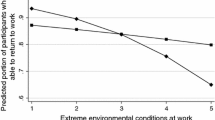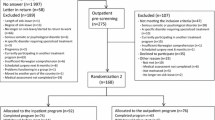Abstract
The aim of this study was to retrospectively explore the prevalence of rehabilitation actions, supportive factors, and obstacles for rehabilitation among home care workers with musculoskeletal disorders, especially focusing on aspects related to occupational rehabilitation. All home care workers in Sweden whose disability pension was approved in 1997 and 1998 because of a musculoskeletal disorder, were selected (n = 373). Data, covering aspects of the rehabilitation process and conditions in working life 5 and 15 years prior to their disability pension, were collected from a questionnaire. The majority considered that the disorder leading to a disability pension was caused by their work, but only one-third of them had their occupational disorder formally approved. Only one-third of the study group received occupational rehabilitation. However, an approved occupational disorder was related to higher prevalence of occupational rehabilitation. In the age group 60–65, few home care workers received rehabilitation. The majority perceived good support from their supervisor and working team, but no support with regard to lowering physical demands. Modification and reduction of physical demands might improve both sustained work ability in home care work and the outcome of the rehabilitation.
Similar content being viewed by others
REFERENCES
Brulin C, Goine H, Edlund C, Knutsson A. Prevalence of long-term sick leave among home care personnel in northern Sweden. J Occup Rehab 1998; 8: 104–110.
Ono Y, Lagerström M, Hagberg M, Lindén A, Malker B. Reports of work-related musculoskeletal injury among home care service workers compared with nursery school workers and the general population of employed women in Sweden. Occup Environ Med 1995; 52: 686–693.
Dellve L, Herloff B, Karlberg K, Hagberg M, Lagerström M, Allebeck P, et al. Socioeconomic determinants of occupational injuries and diseases among the total work force of home care workers in Sweden-An eco-epidemiological study. 2001 (Submitted).
Myers A, Jensen RC, Nestor D, Rattiner J. Low back injuries among home health aides compared with hospital nursing aides. Home Health Care Service Q 1993; 14: 149–155.
Torgén M, Nygård C, Kihlbom Å. Physical workload, physical capacity and strain among elderly female aides in home-care service. Eur J Appl Physiol 1995; 71: 444–452.
Dellve L, Lagerström M, Hagberg M. Work system risk factors for disability pension among home care workers. A case-control study. 2001 (Submitted).
Selander J, Marnetoft S-U. Risk factors for disability pension among unemployed women on long-term sick leave. Int J Rehab Res 1999; 22: 277–282.
Crook J, Moldofsky H, Shannon H. Determinants of disability after a work-related musculoskeletal injury. J Rheumatol 1998; 25: 1570–1577.
Ahlgren C, Hammarström A. Has the increased focus on vocational rehabilitation led to an increase in young employee's return to work after a work-related disorder? Scand J Public Health 1999; 27: 220–227.
Lindh M, Lurie M, Sanne H. A randomized prospective study of vocational outcome in rehabilitation of patients with non-specific musculoskeletal pain: A multidisciplinary approach to patients identified after 90 days of sick leave. Scand J Rehab Med 1997; 29: 103–112.
Ekberg K, Wildhagen I. Long-term sickness absence due to musculoskeletal disorders: The necessary intervention of work conditions. Scand J Rehab Med 1996; 28: 39–47.
Linton SJ. A review of psychological risk factors in back and neck pain. Spine 2000; 25: 1148–1156.
Ekberg K, Björkqvist B, Malm P, Bjerre-Kiely B, Axelsson O. Controlled two-year follow-up of rehabilitation for disorders in the neck and shoulders. Occup Environ Med 1994; 51: 833–838.
Schultz IZ, Crook J, Fraser K, Joy PW. Models of diagnosis and rehabilitation in musculoskeletal pain-related occupational disability. J Occup Rehab 2000; 10: 271–293
Hamberg K, Johansson E, Lindgren G, Westman G. The impact on marital relationship on the rehabilitation process in a group of women with long-term musculoskeletal disorders. Scand J Soc Med 1997; 25: 17–25.
Dellve L, Lagerström M, Hagberg M. Assessment of work system risk factors among home care workers. Arbete och Hälsa 2001; 10.
Quinlan M, Mayhew C. Precarious employment and workers' compensation. Int J Law Psychiatry 1999; 22: 491–520.
Menckel E, Kullinger B, eds. Femtonårs olycksfallsforskning i Sverige (Fifteen Years of Work Injury Research in Sweden). Uppsala: Rådet för arbetslivsforskning; 1996.
Hagberg M, Cristiani D, Courtney TK, Halperin W, Leamon TB, Smith TJ. Conceptual and definitional issues in occupational injury epidemiology. Am J Ind Med 1997; 32: 106–115.
Oleske D, Lavender S, Andersson G, Hahn J, Zold-Kilbourn P, Allen-Toole C, et al. Job exposures as correlates of recovery in population-based rehabilitation intervention for work-related low back disorders. Ann Epidemiol 2000; 10: 481.
Arneson H. Arbetsgivarens rehabiliteringsinsatser och kvinnorsåtergång i arbete (Employers rehabilitation activities and womens return to work). Socialvetenskaplig tidskrift 2000; 5: 421–428.
Söderfeldt B, Söderfeldt M, Muntaner C, O'Campo P, Warg L-E, Ohlsson C-G. Psychosocial work environment in human service organizations: A conceptual analysis and development of the demand-control model. Soc Sci Med 1996; 42: 1217–1226.
DiFabio R. Efficacy of comprehensive rehabilitation programs and back school for patients with low back pain: A meta-analysis. Phys Ther 1995; 75: 865–878.
Lilius G. Ryggrehabilitering i Finland-effekt på sjukskrivning och förtidspensionering (Rehabilitation of patients with back problems in Finland; effects on sick certification and disability retirement). Nord Med 1993; 108: 319–320.
Linton SJ. Preventive Interventions for back and neck pain problems. What is the Evidence? Spine 2001; 26: 778–787.
Hildebrandt J, Pfingsten M, Saur P, Jansen J. Prediction of success from a multidisciplinary treatment program for chronic low back pain. Spine 1997; 22: 990–1001.
Ahlgren C, Hammarström A. Back to work? Gender experiences of rehabilitation. Scand J Public Health 2000; 28: 88–94.
Torgén M, Winkel J, Alfredsson L, Kihlbom Å. Evaluation of a questionnaire-based information on previous physical work loads. Stockholm MUSIC 1 Study Group. Musculoskeletal Intervention Center. Scand J Work Environ Health 1999; 25: 246–254.
Author information
Authors and Affiliations
Corresponding author
Rights and permissions
About this article
Cite this article
Dellve, L., Lagerström, M. & Hagberg, M. Rehabilitation of Home Care Workers: Supportive Factors and Obstacles Prior to Disability Pension Due to Musculoskeletal Disorders. J Occup Rehabil 12, 55–64 (2002). https://doi.org/10.1023/A:1015001612667
Issue Date:
DOI: https://doi.org/10.1023/A:1015001612667




